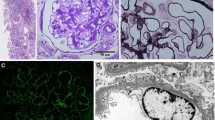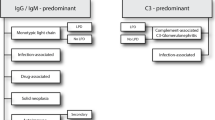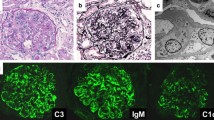Summary
Diffuse glomerulonephritis with the nephrotic syndrome was observed in two patients aged 3 years 8 months and 27 years, both of whom had ventriculo-atrial shunts. Removal of the shunts resulted in marked improvement in the first and complete recovery in the second patient. Serum β1C-globulin concentrations were initially low and returned to normal values. Cultures taken from cerebrospinal fluid and valve grew Staphylococcus albus in the pediatric patient and were negative in the adult patient. Initial renal biopsies obtained immediately before shunt removal showed diffuse intra- and extracapillary glomerulonephritis type III (crescent formation in over 90 percent of the glomeruli) in the first patient, and diffuse intracapillary proliferative and exudative glomerulonephritis in the second patient. Repeat biopsies were performed, on the first patient 22 months, and on the second patient 7 months after shunt removal. In the first patient, half of the glomeruli were sclerosed, and the others exhibited slight mesangial proliferation with some capsular adhesions. The repeat renal biopsy from the adult patient showed mesangial proliferation with lobulation. Immunofluorescence studies in both patients revealed positive staining in a coarsely granular pattern against IgG, IgM, and β1C globulin. On electron microscopy, subendothelial deposits were still visible in the second biopsies of both patients. Glomerulonephritis associated with infected ventriculo-atrial shunt is probably mediated by antigen-antibody complexes. Recovery is possible in spite of severe renal lesions since the antigen can be eliminated at once by removal of the shunt.
Zusammenfassung
Bei 2 Patienten im Alter von 3 8/12 bzw. 27 Jahren entwickelte sich nach Anlegen eines ventriculo-atrialen Shunt eine diffuse Glomerulonephritis mit nephrotischem Syndrom. Die Entfernung des Shunt führte beim ersten Patienten zu einer raschen Besserung und beim zweiten Patienten zu einer kompletten Heilung des Nierenleidens. Das anfänglich tiefe Serumkomplement (β1C) normalisierte sich. Bei dem Kinde konnte aus dem Liquor und vom Ventil Staphylococcus albus gezüchtet werden. Bei dem erwachsenen Patienten blieben die Kulturen steril. Beim ersten Patienten ergab die Nierenbiopsie vor Entfernung des Shunt eine diffuse intra- und extracapilläre Glomerulonephritis, Typ III (subakute Glomerulonephritis), beim zweiten eine diffuse intracapilläre proliferative und exsudative Glomerulonephritis. Bei beiden Patienten wurde 22, bzw. 7 Monate nach Entfernung des Shunt eine zweite Biopsie entnommen. Beim ersten Fall waren rund die Hälfte der Glomeruli hyalinisiert. Die übrigen zeigten mäßig ausgeprägte segmentäre Läsionen. Halbmonde waren keine mehr nachweisbar. Beim zweiten Patienten bestand nach 7 Monaten noch eine deutliche mesangiale Proliferation mit Lobulierung der Glomeruli. Immunfluorescenzmikroskopisch konnte in beiden Fällen in den Glomerulusschlingen IgG, IgM und β1C in grob granulärer Form nachgewiesen werden. Elektronenmikroskopisch fanden sich bei beiden Patienten auch in der zweiten Biopsie subendotheliale Ablagerungen.
Die nach einem infizierten ventriculo-atrialen Shunt auftretende Glomerulonephritis ist mit großer Wahrscheinlichkeit durch Immunkomplexe bedingt. Da durch Entfernung des Shunt das Antigen sofort entfernt werden kann, ist selbst bei schweren Nierenläsionen eine weitgehende Besserung möglich.
Similar content being viewed by others
Reference
Bauby, C.: Contribution à l'étude de la néphrite de shunt. Thèse, Faculté de Médecine, Paris Lariboisière. St. Louis: 1972.
Black, J. A., Challacombe, D. N., Ockenden, B. G.: Nephrotic syndrome associated with bacteremia after shunt operations for hydrocephalus. Lancet 1965 II, 921–924.
Campbell, A., Futrakul, P., Musgrave, J. E., Surapathana, La-Or, Eisenberg, C. S.: Bacillus cereus prosthesis nephritis. (Abstract) Proc. Second International Symposium of Pediatric Nephrology, Paris 1971, p. 167. Paris: Editions Sandoz 1971.
Dixon, F. J., Feldman, J. D., Vazquez, J. J.: Experimental glomerulonephritis: Pathogenesis of laboratory model resembling spectrum of human glomerulonephritis. J. exp. Med. 113, 899–920 (1961).
Gutman, R. A., Striker, G. E., Gilliland, B. C., Cutler, R. E.: The immune complex glomerulonephritis of bacterial endocarditis. Medicine (Baltimore) 51, 1–25 (1972).
Habib, R.: Classification anatomique des néphropathies glomérulaires. Pädiat. Fortbild. Praxis 28, 3–47 (1970).
Habib, R., Courtecuisse, V., Leclerc, F., Mathieu, H., Royer, P.: Etude anatomo-pathologique de 35 observations de syndrome hémolytique et urémique de l'enfant. II. Arch. franç. Pediat. 26, 391–416 (1969).
Holland, N.: Hypocomplementemic glomerulonephritis associated with Micrococcus infection of ventriculo-atrial shunt. (Abstract) 37th Annual Meeting Society for Pediatric Research, Atlantic City, N. J., p. 125 (1967).
Kaufman, D. B., Logan, L., McIntosh, R. M.: The nature of the antibody in a patient with immune complex renal disease. (Abstract) Pediat. Res. 3, 363 (1969).
Kaufman, D. B., McIntosh, R. M.: The pathogenesis of the renal lesion in a patient with streptococcal disease, infected ventriculo-atrial shunt, cryoglobulinemia and nephritis. Amer. J. Med. 50, 262–268 (1971).
Molz, G., Doswald, T.: Diffuse Glomerulonephritis bei Staphylokokken-infizierter ventrikuloatrialer Liquordrainage. Schweiz. Arch. Neurol. Neurochir. Psychiat. 107, 223–230 (1970).
Moncrieff, M. W., Glasgow, E. F., Arthur, L. J. H., Hargreaves, H. M.: Glomerulonephritis associated with Staphylococcus albus in a Spitz Holter valve. Arch. Dis. Child. 48, 69–72 (1973).
Proesmans, W.: Proliferative glomerulonephritis with crescents. (Abstract) Proc. Second International Symposium of Pediatric Nephrology, Paris 1971, p. 91–92. Paris: Editions Sandoz 1971.
Rames, L., Wise, B., Goodman, J. R., Piel, C. F.: Renal disease with Staphylococcus albus bacteremia. A complication in ventriculoatrial shunts. J. Amer. med. Ass. 212, 1671–1677 (1970).
Smith, I. M., Beals, P. D., Kingsbury, K. R., Hasenclever, H. F.: Observations on Staphylococcus septicemia in mice and men. Arch. intern. Med. 102, 375–388 (1958).
Sonsino, E., Nabarra, B., Kazatchkine, M., Hinglais, N., Kreis, H.: Les glomérulonéphrites prolifératives extracapillaires dites „glomérulonéphrites malignes“. In: Actualités Néphrologiques de l'Hôpital Necker, p. 119–161. Paris: Editions Flammarion 1972.
Stauffer, U. G., Csomor, A., Plüss, H. J., Hitzig, W. H.: Diffuse Glomerulonephritis infolge infizierten ventrikuloatrialen Shunts. Schweiz. Med. Wschr. 100, 1288–1291 (1970).
Stickler, G., Shin, M. H., Burke, E. C., Holley, K. E., Miller, R. H.: Segar, W. E.: Diffuse glomerulonephritis associated with infected ventriculo-atrial shunt. New. Engl. J. Med. 279, 1077–1082 (1968).
Author information
Authors and Affiliations
Rights and permissions
About this article
Cite this article
Wegmann, W., Leumann, E.P. Glomerulonephritis associated with (infected) ventriculo-atrial shunt. Virchows Arch. Abt. A Path. Anat. 359, 185–200 (1973). https://doi.org/10.1007/BF00550038
Received:
Issue Date:
DOI: https://doi.org/10.1007/BF00550038




